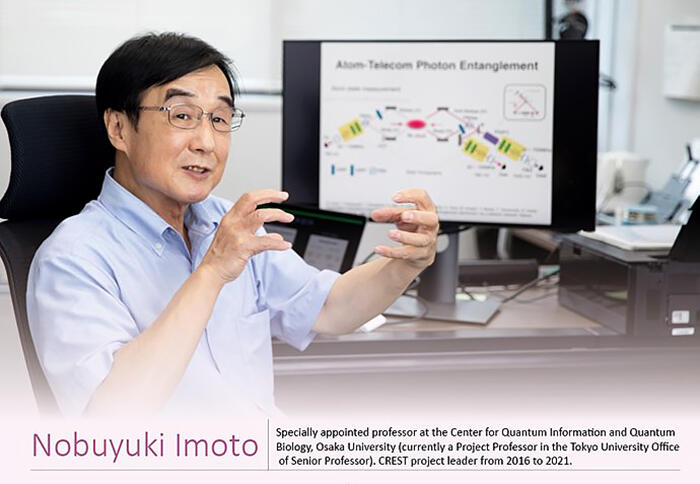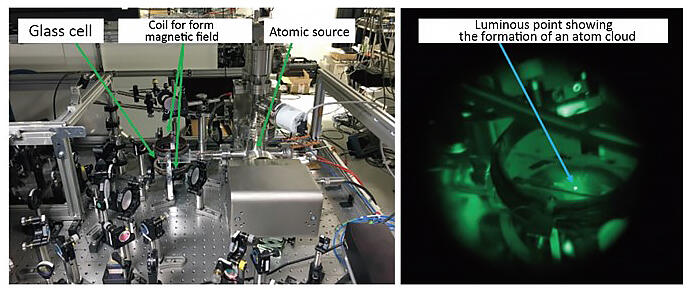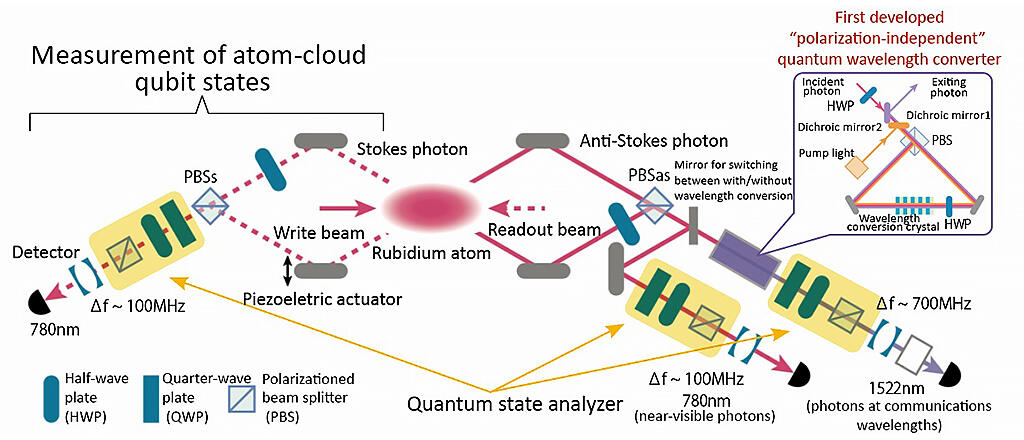Once quantum computers are routinely built, it is expected that they will be connected in a quantum network that will allow us to send and receive vast amounts of quantum information, which in turn will exponentially increase the capabilities of the entire quantum computer network. To realize this system, research and development of quantum computer networks using optical fibers has begun in the world's leading countries. Nobuyuki Imoto, a specially-appointed professor at the Center for Quantum Information and Quantum Biology, Osaka University (currently a Project Professor in the Tokyo University Office of Senior Professors), has successfully demonstrated the principle of a quantum repeater that is capable of delivering quantum state of photons over a long distance with minimal reduction in speed due to optical loss, making steady progress toward realizing a "global quantum network."

Witnessing the birth of the concept in England. Troublemakers (quantum noise and entangleemt) are indeed the keys that opens the door to new possibilities
Today's information society is driven by the development of information and communications, symbolized by the Internet. In particular, optical fiber networks, which can transmit large amounts of data at high speeds, play an important role. Meanwhile, as the information society progresses, there is growing interest in quantum communication as a highly secure communication method.
In quantum communication, the unit of information is not a bit, but a "qubit" that can be in a superposition state of "0" and "1". The quantum information is transmitted between these qubits based on a property called entanglement, which is unique to quantum mechanics, whereby when the quantum state of one qubit is determined, the quantum state of the other is also determined accordingly. For this reason, in order to build a quantum network that uses optical fiber, a new technology that can support quantum information is necessary in addition to the optical communication technology developed thus far.
The basic idea is to divide the long path between the sender and receiver into short segments, and form an entanglement between quantum memories placed at both ends of each section, and then relay the entanglement of these segments, which results in forming a long-distance entanglement between the sender and receiver. Using this, the quantum signal on the sender side can be teleported to the receiver side using this entanglement. Here, if the process is repeated until the entanglements are formed simultaneously in all of the segments, the waiting time increases exponentially with the distance, as in the direct transmission (no-relay case). However, if the entanglements are preserved in the segments where they were formed successfully, and the formation process is only repeated for those that have not, then the exponential slowing down can be reduced to a polynomial level.
This will require devices and systems based on entirely different principles from current optical communication equipment, such as technology to read and write quantum information with light without destroying it, quantum repeaters that can temporarily store entanglement during transmission, and quantum receivers to receive the information. Research on these kinds of "long-distance quantum networks" has been pursued by Nobuyuki Imoto, a specially appointed professor at the Center for Quantum Information and Quantum Biology, Osaka University (currently a Senior Professor at Tokyo University).
Professor Imoto began his career in 1977 at Nippon Telegraph and Telephone Public Corporation (now NTT), where he conducted research on optical communication at the Musashino R&D Center. NTT began developing optical fiber networks in the mid-1980s, and Professor Imoto contributed to the enhancement of information networks through technological innovations such as optical wavelength-division multiplexing communication. From 1985, he began research on the adverse effects of quantum noise on optical communications.
While he was trying to find a way to resolve adverse effects caused by quantum phenomena, what led to Professor Imoto's full-fledged entry into the quantum world was an incident at the University of Essex in England, where he was working in the 1990s. "I was fortunate enough to witness the birth of the concepts of quantum computing and quantum cryptography. I had been interested in quantum mechanics since my student days, but I became aware once again of how fascinating it was, and I began to research quantum information processing." Quantum phenomena, which had been troublemakers for Professor Imoto, now became a key to opening up new possibilities for optical communications. After becoming a professor at Osaka University in 2004, he continued basic research to successfully develop long-distance quantum networks.
Conversion the optical wavelengths to suitable ones for optical communications. Successful transmission over 10 kilometers
Based on his research track record, Professor Imoto put together a team mainly centered around Osaka University, and began a CREST research project on "global quantum network" from 2016. The major goal was to investigate the elemental technologies related to quantum relay, which will be the key to achieving a long-distance quantum network. Currently, long-distance optical fiber networks have repeaters that are installed every few tens of kilometers to store the transmitted data while amplifying the attenuated light and sending it onward. For quantum communications, these fiber-optics repeaters would have to be replaced with ones for quantum communications.
Near-visible light with a short wavelength of 780 nanometers (one-billionth of a meter) is used to read and write information from and to quantum memory, which functions to store information in a quantum relay. However, fiber-optic transmission at this wavelength results in extremely high light attenuation, which is a major roadblock.
Professor Imoto's research team therefore developed a high-performance wavelength converter that can convert visible light, which can read the information held in quantum memory, into near-infrared light with a 1522 nanometer wavelength suitable for optical communications, without destroying the quantum information. In 2016, the team confirmed that quantum information that uses quantum memory in cooled rubidium atoms can be converted into near-infrared light and then transmitted through optical fiber, allowing read/write transmission while maintaining the quantum information. (Fig. 1)
Fig. 1: Rubidium atom cloud quantum dot generator (left)
and luminous point showing the formation of an electron cloud (right)

Building even further on this achievement, by integrating a wavelength converter and an optical interferometer, the team successfully developed a "polarization-independent wavelength converter" in 2018 that can convert wavelengths into the communications wavelength range without changing the polarization state of the photons. (Fig. 2) It also achieved quantum communication over a distance of over 10 kilometers, a world record length at that time, by converting the photons emitted from calcium ions into wavelengths and maintaining their quantum nature. Professor Imoto relates that "with this device, we were able to demonstrate that a quantum network can be formed between atomic quantum memories separated by long distances using an optical fiber network, which is capable of long-distance secure communications."
Fig. 2: Quantum network with a polarization-independent wavelength converter

Subsequently, in 2019 the team successfully conducted the world's first proof-of-principle experiment of an "all-optical quantum relay" consisting only of optical devices, marking a significant achievement on the path toward the realization of a global quantum network that can operate at high speed and with low energy consumption. Meanwhile, along with demonstrating the completely new principle of "time reversal," which has become possible for the first time through quantum entanglement, the team conducted the world's first "adaptive Bell measurement," which seeks to determine which of the possible entanglement states of two particles is largest. This information is essential for quantum relay, and the experiment was a great sensation.
Professor Imoto sums things up by saying, "there are many challenges ahead of us, including network architecture, research and development of lossless integrated optical circuits and quantum entangled light sources, and quantum receivers for highly efficient communications, but I am confident that we have made great strides with this series of research toward the development of a global quantum network."
Quantum communications is a technological innovation that will bring about far-reaching innovation not only in optical fiber networks, but also in wireless communications, including satellite communications. Quantum cryptographic communications are already in use today, and going forward, their importance as a technology that underpins social infrastructure will only increase further.
(Text: Shinji Moribe, photo: Hideki Ishihara)




